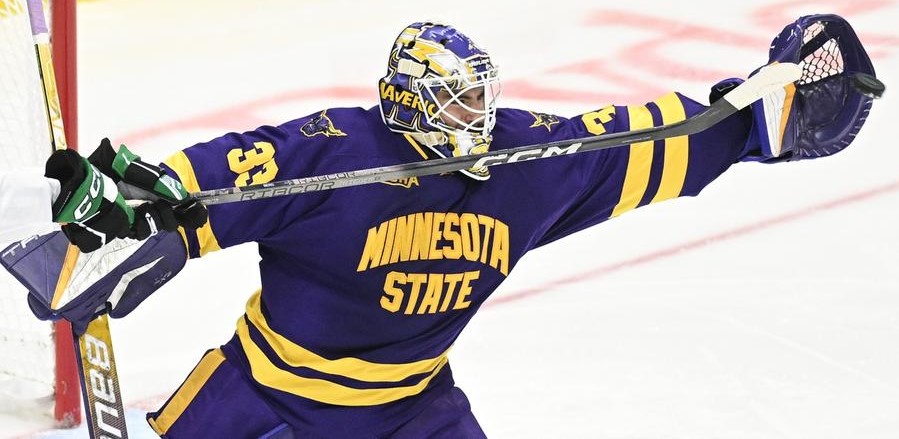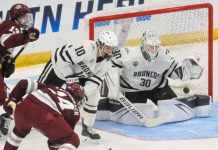
Each week during the season, we look at the big events and big games around Division I men’s college hockey in Tuesday Morning Quarterback.
Paula: Well, Dan, we’re in mid-February, which means that time is running out on the regular season. The competition is tightening, especially as teams attempt to finish as high as they can in conference standings for better playoff position and the regular-season title is up for grabs in several conferences.
We saw that in play among the top teams in the USCHO.com Poll, resulting in a new No. 1 this week – a team that didn’t play a game last weekend.
Michigan State regains the top spot in the poll as voters were clearly torn. The Spartans received 23 first-place votes to knock Boston College down to No. 2 after the Eagles posted losses in two of their last three games. I don’t think that the loss to Boston University in the Beanpot title game Feb. 10 would have affected BC’s standing if the Eagles had followed that up with a sweep of No. 16 Massachusetts, but a split with the Minutemen last weekend gave voters some pause.
That split also opened the door for No. 4 Maine to move into a tie for first place in Hockey East with a tie and win against New Hampshire.
The Eagles still received 11 votes for first place in the poll. My vote went to Western Michigan, whose sweep of Omaha puts some distance between the Broncos and the second-place Sun Devils. No. 12 Arizona State lost to and tied Minnesota Duluth.
The sweep wasn’t the only reason the Broncos earned my vote. Western Michigan is 9-1-0 in NCHC play since the start of 2025.
Things got interesting in the conference I cover, too. With Michigan State idle, No. 5 Minnesota had a chance to gain some ground on the Spartans, but a loss and tie to No. 10 Michigan kept the Golden Gophers in second place – a spot they now share with No. 7 Ohio State, who swept Wisconsin.
There’s movement in other places in the poll but, more importantly, in PairWise Rankings where some teams are working hard to play themselves into the tournament, most notably No. 14 Quinnipiac and No. 18 Penn State.
What stories do you see developing here, Dan? What are we looking at now and in the weeks remaining in the regular season?
Dan: We’ve known for a while that the cut line for the national tournament is going to land around the No. 14 spot, but the tightening around that position is getting more and more pressure-packed as we’re nearing the end of the season. Even for Quinnipiac, which is credibly earning its way into another Cleary Cup as the ECAC regular-season champion, won’t likely stay above the cut line if it loses a postseason game or doesn’t win the Whitelaw Cup as league tournament champion. Even worse would be a two-game loss in the quarterfinal series, and even worse still would be a series loss to any of the teams like Harvard, Brown or Princeton.
There’s simply not enough wiggle room remaining for teams without a scheduling benefit, but there’s also a stark difference in how those teams are gambling with their RPI points. Take UMass, for instance, which gained extra credit for beating Boston College on the road before dropping Saturday’s game at home. The team’s final three weekends are against New Hampshire, UMass Lowell and Maine, the latter two of which are ahead of the Minutemen in the Pairwise. Gaining wins against those two teams or even not losing to New Hampshire makes it harder for a team like Quinnipiac to close its .0013 gap in the RPI because the Bobcats only play Yale, Brown, Clarkson and St. Lawrence – a group that has two teams under the No. 50 spot in the Pairwise Rankings and nobody higher than No. 21.
A team like Penn State, meanwhile, has to make up nearly a full percentage point within the RPI but plays both Michigan State and Minnesota before entering into the Big Ten’s postseason. Considering how well Penn State’s played lately, I would then argue that the Nittany Lions have a better chance of making the postseason as an at-large than Quinnipiac despite sitting well outside of the present company bubble.
I’ve taken a few shots at Quinnipiac through this whole thing, but I want to make one thing clear: this is where playing your best hockey matters the most, and for those teams around the cut line, there’s tons of pressure to make quick adjustments on a game-to-game basis.
UNH fell off the cliff because of a bad run in its conference, and a team like Minnesota State doesn’t have the same juice within the CCHA to gain the same ground on Arizona State, which finally ran into a bit of a wall this weekend when it lost and tied Minnesota-Duluth on the road. Even then, Arizona State plays Western Michigan this weekend, so a win in either game gets the Sun Devils right back into a hunt that’s starting to leave teams behind.
Paula: Yeah, I’m looking at strength of schedule pretty hard this week, particularly in the Big Ten. The B1G team that stands to lose the most is Michigan State, who faces both Penn State and Notre Dame to end the season. The Spartans will play in the tournament, but losses in the final two weeks can knock them out of the top spot in a regional, which is where they’re sitting now and have for pretty much the whole season.
Minnesota is the other B1G team currently looking at a No. 1 regional seed, and losses in remaining games against Ohio State probably won’t undermine that, but losses to Penn State in the final weekend might.
Of course, this is something that many top teams contend with in their conference playoffs. If they’re high enough in the PWR, they don’t have to worry about dropping out of tournament contention, but they can draw less favorable opponents with lower PWR positions. I imagine that a lot of coaches are courting insomnia and/or ulcers at this time of the year.
I look at how strong the Big Ten is this season and the advantage that gives a team like Penn State – just that ability to play their way into the national tournament, potentially. Then I look at Atlantic Hockey and Holy Cross, a team that has a solid chance of finishing the regular season with 20 wins and yet may not see NCAA post-season play.
The Crusaders are unbeaten (11-0-1) in conference play in the second half, just a hotter-than-hot streak in which they’re averaging over 4.30 goals per game while allowing fewer than two per game. Liam McLinskey is averaging .62 goals per game this season, tied with Minnesota’s Jimmy Snuggerud for 10th in the nation. McLinskey has been one of the most consistent offensive players in the country all season, and his play has earned him some well-deserved Hobey Baker talk.
For as good as they are, though, the Crusaders sit at No. 27 in the Pairwise. Should they fail to capture the AHA playoff championship, their brilliant season will be over Mar. 22 or sooner.
McLinskey brings to mind the Hobey and Richter awards. Who are you liking for the Hobey Hat Trick and Richter finalists?
Dan: A couple of weeks ago, I talked about the Hobey Baker and the Richter Awards through a decided eastern lens. My picks – Ryan Leonard and Jacob Fowler – are both starring for Boston College, and the Eagles (disclaimer: for whom I work) were steamrolling through teams ahead of the Beanpot first round game that hadn’t happened when we were bantering through TMQ.
The last week opened a bit of daylight for the rest of the country, in my opinion, and I’m not fishing towards dark horses or unknown names who I’m lodging into the conversation. Over the past two weeks, I’ve found myself opening the debate internally in my own head, and I’m learning now towards Aiden Fink as a name to watch for the Hobey Baker and Alex Tracy as a name deserving serious consideration for the Richter Award.
I’ll start with Tracy and his 733 saves, 1.53 goals against average, and .941 save percentage. He’s been electric over the past couple of months in terms of shutting down every team he’s faced. He hasn’t allowed more than three goals in any of his appearances and went on a tear between November and January where he allowed two or less goals to every single opponent. The lone three-goal games since the turn into 2025 came against Northern Michigan and St. Thomas, but even his losses to Michigan Tech and Ferris State involved impressive performances where the Mavericks endured an offensive power outage.
Fink, meanwhile, is the single-most important reason why Penn State is surging towards the tournament bubble and why I wouldn’t want to face that team under any circumstances. Just under half of his 44 points have come since the first of the year, and he rebounded from his two pointless games by scoring a pair of goals against both Ohio State and Michigan. He’s had at least one goal in 10 games since playing Army West Point on Jan. 12, and he’s now one of the nation’s top scorers on par with Ryan Leonard.
I’m wondering out loud if Leonard, arguably the most talented player in college hockey right now, will deal with a demerit for the number of empty-net goals he’s scored, which is about double Fink’s total. Po-tay-to, po-tah-to, but I know voters are finicky about silly things.
I do want to shift gears a bit because my wind just wandered a bit. You mentioned Holy Cross and leading Atlantic Hockey, but this past weekend was the final two-game series of the year between Army West Point and Air Force. From an apolitical conversation, the matchups between those two teams always seem to embody the best things in college hockey. This year, it felt more special because of Brian Riley’s impending retirement. For the final time, a Riley was behind the bench for the nation’s rivalry.
I think I’m gaining more perspective on that one factoid as the year ends. I’m going to miss Brian’s candor and gentlemanly attitude within “our league” in the AHA, but I know the entire national landscape loves and respects him.
As college hockey evolves, this is a fact that some of the most experienced coaches are angling for retirement. Count me among those who owe a debt of gratitude to Coach Riley and all he’s meant to the game.
Paula: I love the love for Fink, as you may imagine, and the advocacy for Tracy. It really can’t be said that anyone in the Big Ten flies under the radar, and Fink was named to the preseason all-Big Ten team by coaches for a reason. You’ve admirably outlined the reasons here.
And Tracy is a phenom this season, a true dark horse. I fear that he’ll be overlooked because of where he plays – which seems to be a theme for our column this week, in some ways.
On to Brian Riley, one of the great gentlemen of college hockey. My professional contact with Coach Riley has been limited, but he’s always been knowledgeable, gracious, and generous whenever I’ve spoken with him or observed him interacting with others. His reputation is sterling and with good reason. It’s also a bit of a mental challenge to think of Army hockey without the Riley family, given the last 75 years.
Your mention of Brian Riley also brings to mind two other great coaches – two other really wonderful men – who are retiring. We knew at the start of the year that Jeff Jackson would step away from the bench at Notre Dame and that Fighting Irish alum and associate head coach Brock Sheahan will lead the Irish beginning next season.
Jackson is one of the most knowledgeable coaches I’ve met and through my years in covering hockey, I’ve always appreciated his candor. I’ve also appreciated Notre Dame’s ability to develop players under Jackson’s tenure.
Then there’s Bob Daniels. In January, Daniels announced that he would be retiring after 33 years at Ferris State. From my earliest days covering college hockey, Daniels proved himself to be one of the nicest coaches in the business. Yes, he’s a solid coach, he’s knowledgeable, he’s become a legend in Big Rapids and to all who know him in the college hockey world, but you and I know that niceness is underrated.
And it’s such a small world, our little college hockey universe. I think of current Tampa Lightning assistant Jeff Blashill and how he grew up on the campus of Lake Superior State, living next door to current Notre Dame associate head coach Paul Pooley when Jeff’s father, Jim, taught at Lake State and how much Jackson, the head coach then, influenced Blashill. Blashill played for Daniels at Ferris State, too. One small story from a very small world.
Of all my cherished Daniels memories – aside from his stories about teaching Blashill how to golf, which may or may not be entirely accurate – my favorite is when the NCHC was forming and people involved in the league were bandying about potential conference names. They were purportedly thinking of calling it the “Super League,” and when Daniels caught wind of that, he said that maybe the league formed by the old CCHA and WCHA teams left behind by what is now the NCHC should call themselves the “Super Duper League.”
I heard that secondhand and when I called Daniels to ask him if I could use that on the record he said, “Absolutely.”
Sometimes I wonder if we college hockey fans appreciate just how good we have it.
And on that note, I do want to point out something regarding the Four Nations tournament. In the U.S. win over Canada Saturday, every single player on the American scoresheet was an NCAA alum. Every goal, every assist, every save.
College hockey really is something special.
Dan: It really is, and the current success levels inherent to college hockey remind me of two separate branches. The first is the natural link to the USA development pipeline and how it’s really reaping the benefits of its success and sustainability within the World Junior circuit. College hockey, we argued a couple of months ago, is partially overtaking the CHL and the Canadian junior system, and it’s likely to skew even further towards the American side after the floodgates open for those Canadian league imports. By its very nature within the growth of the game, we’re seeing an explosion of players that came through college before NIL and the transfer portal, and that’s pretty impressive.
The second is more personal for me because it echoes a bit of the women’s game and the success enjoyed by USA Hockey after the college game produced its gold medal in 2018. I still remember watching the Americans win in 1998 with a team built by Tara Mounsey, a high school-aged Angela Ruggiero, Colleen Coyne, Karyn Bye, Cammi Granato, AJ Mleczko and Katie King, not to mention Sarah Tueting in net.
They all came through college hockey, and in 2018, Alina Muller and Marie-Philip Poulin led scoring despite not winning gold medals. The American team, meanwhile, won its first gold since 1998 because of a roster built from the collegiately-developed all stars. Personally speaking, especially now that I have two daughters, I’ve found myself drawn to how college hockey was the conduit for growth that led to the PWHL and the ongoing reset of equality standards.
Last point from me, though, and it’s about the Four Nations and specifically Team USA. I don’t get hung up on off-ice rivalries between the Americans and Canadians (more direct: I’m not addressing the anthem thing. The whole argument, to me, is kind of a pointless endeavor), but there’s one piece of off-ice business that separates Team USA apart from any other team on the international stage.
More than anything, I’m blown away from USA’s commitment to remembering the Gaudreau brothers, and the pictures and images of handing out Johnny’s No. 13 to the player of the game while inviting Guy Gaudreau into team pictures is, to me, the very best part of both college hockey and the American hockey system. At the risk of getting wispy, I wish this tournament, along with the Olympics and the World Cup of Hockey, received a chance to have Johnny skate next to someone like Auston Matthews.
It’s an honor, in not so many words, for American hockey to continue remembering both Johnny and Matthew Gaudreau. Seeing that jersey means the world, and I hope that this tournament, for all who continue to remember and mourn that duo, is providing an extra layer of comfort within the American success.


